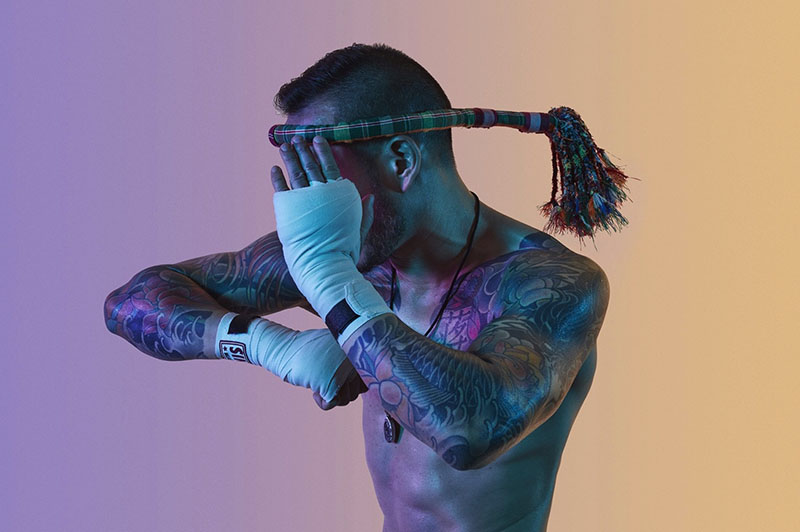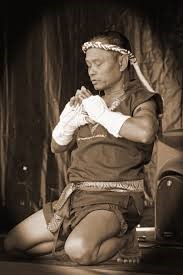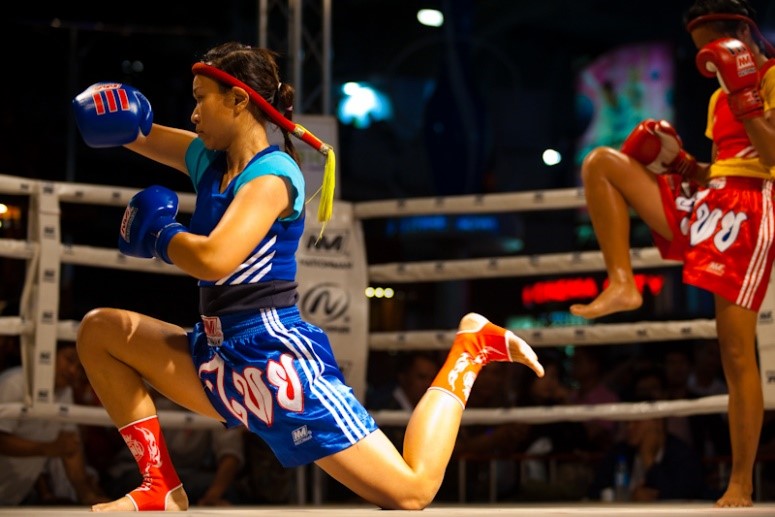
Muay Thai, the art of eight limbs, but also known as simply “Thai boxing,” is a devastatingly effective martial art of Thailand characterized by the combined use of fists, elbows, knees and shins. In recent years, competitions in Muay Thai have spread throughout the western world and many foreigners from the U.S., Europe, South America, etc. travel to Thailand for personal training with individuals who have trained in the art since their childhood.
Inscriptions from stone columns at the Buddhist temples of Sukhothai (Thailand’s capital from 1238-1409 CE) indicate frequent conflict with neighboring countries Burma and Cambodia. Thus, the city required its soldiers to not only master the use of swords and spears, but also weaponize the body in close person-to-person combat. By the Great Era (1590-1604 CE), King Naresuan of Thailand established a corps of worthy young warriors skilled with weapons and boxing to fight a guerilla war against Burma and subsequently freed Thailand from Burmese oppression. Following the victory, Thailand experienced several years of peace and, in this time, Muay Thai was promoted as sport both for youth development and cultural entertainment. Boxing rings were established in playgrounds and the boxers learned to wrap their hands with cloth dipped in a thick tar for protection. The boxers would don a mongkon head band and pa-pra-jiat amulets wrapped around each of their upper arms during a fight. A boxing bout typically involved gambling and the fight did not end until there was a clear winner. As the sport evolved, villages would often challenge one another to Muay Thai matches and the activity became a central event of all folk plays and festivals.

An excerpt from the book Muay Thai, the Art of Fighting:
“During the early part of the Ayutthaya period the Department of Royal Boxing was founded. One of its responsibilities was to recruit young talented boxers to fight for the King’s entertainment. The top boxers were chosen for the Royal Quarries, called Thani Lir (chosen guards). They were responsible for the security of the royal palace and the King at all times. These boxers were to become the boxing masters who trained the soldiers and the Princes. In the later part of the Ayutthaya Period, after the second loss to Burma in B.E. 2310 (1767 CE), there was one boxer of note.
Nai Khanomtom was a prisoner of war captured by the Burmese when Ayutthaya was sacked for the second time in B.E. 2310 (1767 CE). In B.E. 2317 (1774 CE), the Burmese King, King Angwa, wanted to hold a celebration for the Great Pagoda in Rangoon. Boxing was included in the celebrations. Good Thai boxers were called on to fight with Burmese boxers. On the 17th of March of that year, Nai Khanomtom fought and defeated 10 Burmese boxers in succession with no rest period between fights. It was the first time that MuayThai was used in competition outside of Thailand. For his achievements, Nai Khanomtom was honored as the Father or MuayThai or the Inventor of MuayThai, and the 17th of March is now named Muay Thai Day.”
Before a Muay Thai bout begins, each boxer performs a “Wai Khru Ram Muay” to honor their boxing teacher, their parents and their ancestors. As a sport formerly performed for the royalty, the Wai Khru would have also included an honoring of the king, however the main intent of the ritual is to formalize the student-teacher relationship.

During a Wai Khru Ram Muay, each boxer enters and circles the ring in a counter-clockwise direction and prays at each corner, accompanied by rhythmic Sarama music. The boxer bows their head at each corner three times to salute Buddha, Rama and the sangha of monks, then begins the Ram Muay, a personal ritual that involves specific movements that can contain clues about the boxer’s trainer or where the boxer is from. The movements also function as a pre-fight warm-up.
Many say that the sport today is brutal and violent and this would be true. Injuries from Muay Thai, like other forms of boxing, can result in disastrous forms of head trauma. Most problematic of all, child boxers of Muay Thai, who, due to a combination of inadequate regulation, cultural pressure and absent reporting, are subject to brain injuries before the age of 15; some even as young as nine years old. As a result, there has been an immense national pushback against the pressure for young children to compete in Thai boxing. An article from The Thaiger includes a statistic from the 13th World Conference on Injury Prevention and Safety Promotion that unless a law is created banning children under 12 from competing in Muay Thai matches, approximately 3% of the new generation will sustain learning disabilities. The exact meaning of the term “new generation” is unclear, however it remains that the culture of Muay Thai does not come without dangers to each and every boxer.
Ultimately, Muay Thai exists as a source of great pride for Thailand and its roots of historical combat against oppressors are not forgotten. Muay Thai has influenced martial arts around the world and it has become widely accepted as the most effective, albeit vicious, striking martial art of today.
For more information:
- Muay Thai, The Art of Fighting
- Vice, Fightland
- Foot and Ankle Problems in Muay Thai Kickboxers
- The Thaiger